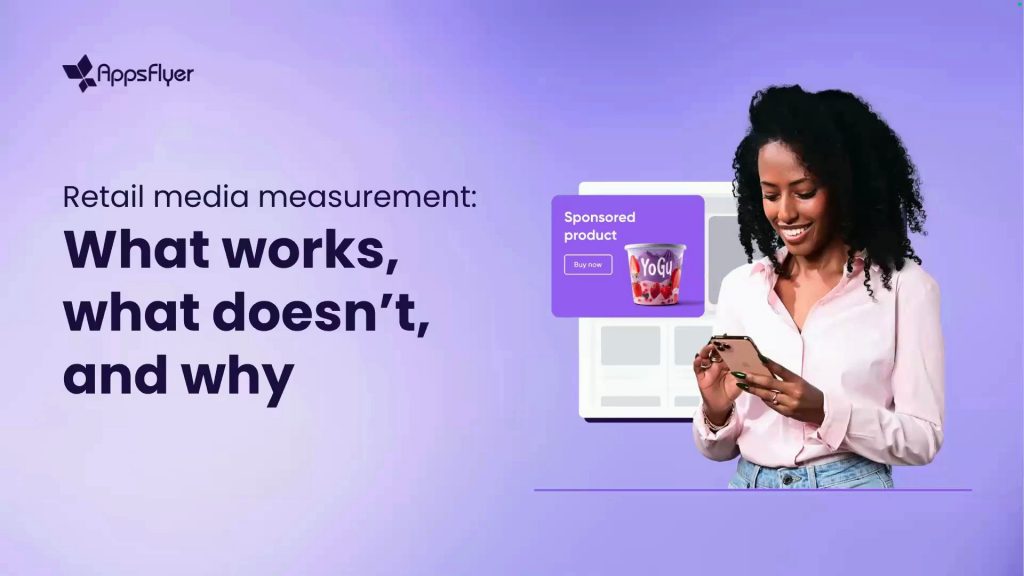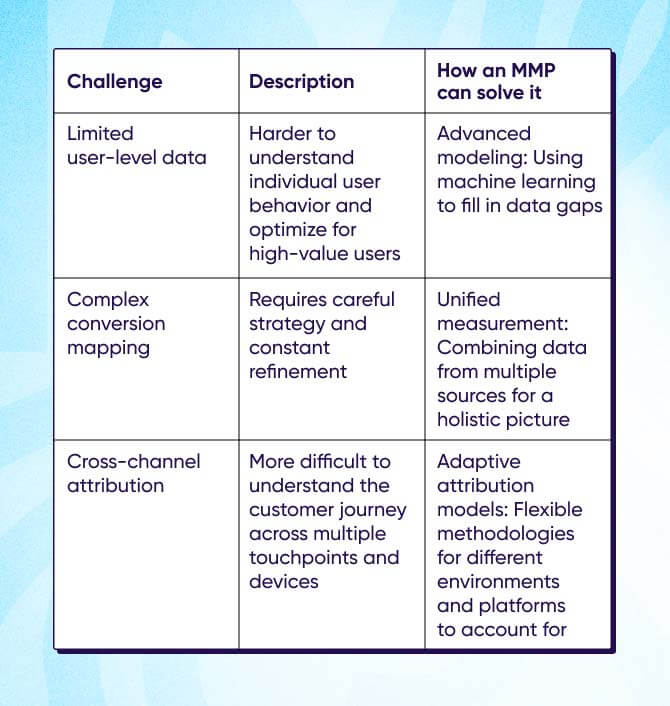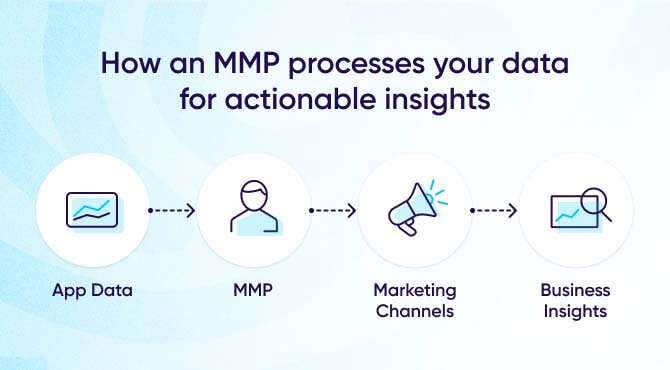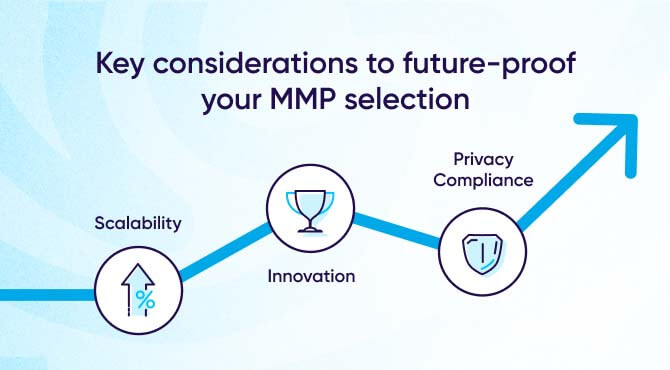
Introduction
In today’s competitive app market, the right data is the make or break factor to your success. Whether you’re considering implementing a Mobile Measurement Partner (MMP) for the first time, or you’ve identified that it’s time to make a switch; you’re likely seeking answers to critical questions:
- How can I understand the true impact of my marketing spend?
- Which channels are delivering the highest-value users?
- Will this solution integrate easily with the tools and platforms I already use?
- How can I keep my data compliant with privacy regulations and platform changes?
This guide is designed to help app marketers cut through the noise and get clear, actionable insights into how to select an MMP that will drive your app’s growth. Whether you’re looking to optimize user acquisition, boost engagement, or protect yourself from fraud, the right MMP can be your secret weapon to transform your marketing efforts from guesswork into a data-driven strategy.
Here’s what we’ll cover
To tackle this critical topic, we’ll cover the following important elements of your MMP purchase:
- Understanding today’s mobile measurement landscape: We’ll briefly summarize the state of mobile marketing and identify the key challenges to better frame the guide.
- Essential features of an MMP: We’ll cover the measurement must-haves, and establish the bare minimum requirements for an MMP.
- Additional MMP factors to keep in mind: We’ll go beyond the feature set to highlight technical and forward-looking considerations.
- Implementation best practices: We’ll provide a checklist to prepare you and your team for a smooth start with your MMP..
- MMP use cases for various teams: Finally, we‘ll showcase some of the primary use cases for various teams throughout your organization that can benefit from your MMP purchase.
- Key takeaways and next steps: We’ll leave you with some key takeaways to keep in mind and provide you with the next steps to take in your buying journey.

Chapter 1
Understanding today’s mobile measurement landscape
As you consider implementing a Mobile Measurement Partner (MMP) for your app, it’s crucial to understand the current mobile ecosystem and the challenges it presents.
The mobile app industry has undergone significant changes in recent years, primarily driven by an increased focus on user privacy. The introduction of iOS 14 in 2021, with Apple’s App Tracking Transparency (ATT) framework and changes to the Identifier for Advertisers (IDFA), marked a turning point in mobile measurement. Google is following suit with its Privacy Sandbox for Android, which will eventually phase out the Google Advertising ID (GAID).
These privacy-centric changes have created several key challenges for app marketers.

Additionally, MMPs are developing privacy-centric solutions, such as data clean rooms, that allow for detailed analysis while respecting user privacy.
As you evaluate MMP solutions, keep these challenges and evolving capabilities in mind. The right MMP will not only help you navigate the current landscape but also prepare you for future changes in the mobile ecosystem. Look for an MMP that demonstrates a commitment to innovation and adaptability, ensuring that you’ll be well-equipped to face whatever challenges the evolving privacy landscape may bring.

Chapter 2
Essential features of a modern MMP
When evaluating Mobile Measurement Partner solutions, certain features are non-negotiable. Let’s explore those must-have capabilities now.
1. Privacy-first measurement
Modern mobile measurement faces two distinct privacy challenges that your MMP needs to address:
Platform requirements
The biggest impact on mobile measurement comes from platform privacy frameworks like Apple’s SKAdNetwork and Google’s Privacy Sandbox.
Your MMP must excel at working within these constraints to deliver actionable insights. This means having comprehensive support for conversion value mapping, aggregated modeling, and measurement solutions that maximize capabilities while respecting platform constraints.
Regulatory compliance
Beyond platform requirements, your MMP should help maintain compliance with privacy regulations like GDPR and CCPA through flexible data collection settings and robust consent management capabilities.
AppsFlyer not only meets these requirements but often exceeds them, offering innovative solutions that maximize insights while respecting both platform privacy frameworks and regulatory requirements. By choosing an MMP with a strong focus on privacy, you’ll be well-prepared to navigate both current and future changes in the mobile ecosystem.
2. Unified cost and attribution
Modern user journeys are complex, spanning multiple channels and devices so naturally marketing budgets are spread across numerous platforms and campaigns.
Your MMP should provide both comprehensive attribution capabilities and accurate cost aggregation to give you the full picture. This combination is essential for understanding not just which channels drive conversions, but also which deliver the best return on investment. By unifying attribution data with cost data across channels, you can optimize both user acquisition strategies and marketing spend efficiency.
AppsFlyer’s comprehensive attribution suite excels in this area, offering industry-leading coverage across platforms and devices, while our cost aggregation solution, ROI measurement, automatically pulls in cost data from over 60 media sources. This powerful combination has helped customers like Halfbrick Studios double their user acquisition growth while maintaining efficient spend across their marketing channels.
3. Deep linking
Converting users across platforms and re-engaging existing users requires seamless user experiences. An MMP’s deep linking solution determines how effectively you can guide users to specific in-app content from any external touchpoint – whether that’s email, web, QR codes, or social media. This capability directly impacts conversion rates and user satisfaction by eliminating friction in the user journey and maintaining context across platforms.
AppsFlyer’s deep linking technology stands out in this area, providing robust deep linking and deferred deep linking solutions that consistently deliver high performance across all platforms and use cases. As demonstrated in a customer story from AirAsia, AppsFlyer’s deep linking capabilities helped drive a 19% improvement in conversion rates and contributed to 15% of total installs through email campaigns alone.
4. Advanced analytics and reporting
Turning data into actionable insights is where the real value of an MMP lies.
Your chosen solution should offer customizable dashboards that align with your specific KPIs and workflows. Look for robust cohort analysis tools that help you understand user behavior over time, along with advanced capabilities like incrementality measurement to truly understand campaign impact. Just as important is having flexible access to your data through comprehensive APIs and raw data exports for deep analysis in your own business intelligence systems.
AppsFlyer offers not just measurement, but also the tools to derive meaningful insights that drive business decisions – from interactive dashboards to granular data access. Wolt leveraged these capabilities to scale their incrementality testing across 23 markets, achieving 10X growth in remarketing budget while cutting their analysis time in half, demonstrating how advanced analytics can transform marketing efficiency at scale.

5. Fraud detection and prevention
Ad fraud can drain your marketing budget and skew your data, making it a critical concern for any app marketer. This is especially true when it comes to testing new ad networks.
Your MMP should offer both real-time fraud detection to block fraudulent installs as they happen and post-attribution fraud protection to catch more sophisticated schemes. Look for solutions that provide customizable fraud rules and comprehensive coverage across different types of fraud, from basic bot attacks to complex click flooding schemes.
AppsFlyer’s multi-layered fraud protection sets a high standard in the industry, safeguarding both budget and data integrity. Gaming company Pixonic saved over $1 million in fraudulent ad spend by implementing Protect360, with 84% of fraud being detected and blocked in real-time – allowing their team to focus on optimizing campaigns rather than fighting fraud.
6. Extensive, easy integrations
Your MMP should seamlessly connect with your entire marketing stack and with the partners you’re buying media from. This means having pre-built connections with all major ad networks and platforms, as well as easy integration with your existing tools for CRM, business intelligence, and more.
Robust APIs for custom integrations and data flows are also essential for flexibility and scalability.
AppsFlyer stands out in this area, offering over 12,000 – more than twice as many total integrations as our nearest competitor, including key integrations with Google, Meta, Snap and TikTok. This level of connectivity ensures that your MMP can grow and adapt with your business, providing a centralized hub for all your marketing data and insights.
7. Creative optimization
When ROAS is the name of the game, it’s really helpful to know which creatives are driving the best performance across different channels and in front of varying audiences. That’s how you’ll know where to double down on your investments and where to stop the bleeding in your acquisition budget.
In a perfect world, your MMP should provide granular insights into creative performance, helping you identify winning combinations of creative elements, audiences, and placements.
AppsFlyer’s creative reporting capabilities enable marketers to analyze creative performance at every level – from broad creative themes down to specific elements – while connecting this data directly to downstream metrics like retention and revenue. This rich creative intelligence has helped customers like Ace Games increase click-through rates by 52% for user-generated content and improve their overall creative success from 55% to 80%.
By prioritizing the above features in your MMP selection process, you’ll be well-equipped to navigate the complexities of modern mobile marketing, unlock valuable insights, and drive sustainable app growth. Remember, the right MMP is not just a tool, but a strategic partner in your app’s success. Choose wisely.
8. Bonus: Data Clean Room functionality
As privacy regulations tighten, data clean rooms are becoming essential for sophisticated marketers. While this is not a deal breaker just yet, if your MMP can provide secure data collaboration capabilities, it’s a huge bonus. DCRs allow you to share and analyze data with partners without risk of exposing individual user information or compromising proprietary data.
With Data Clean Rooms, you’ll want to look for flexible matching capabilities that create valuable insights while maintaining user privacy, along with built-in compliance safeguards to ensure all data usage adheres to relevant privacy laws and user consent.
AppsFlyer’s data clean room solution provides a secure environment for data collaboration, enabling sophisticated analysis while prioritizing user privacy.

Chapter 3
Additional MMP factors to keep in mind
The right feature set matters but there are several critical factors to consider beyond it when selecting an MMP. Your decision will have long-lasting impacts on your marketing strategy and overall business success. Let’s explore the key considerations that should guide your evaluation process.
Accuracy and reliability of data
The foundation of any effective mobile measurement solution is the accuracy and reliability of its data. After all, you’ll be basing crucial business decisions on this information. Look for MMPs with a proven track record of data accuracy and transparent methodologies.
AppsFlyer, for instance, is known for our commitment to data accuracy, employing advanced algorithms and machine learning techniques to ensure precise attribution even in complex scenarios. Our ability to provide a single source of truth across multiple channels and platforms is particularly valuable in today’s fragmented digital landscape.
Ease of implementation and use
The value of an MMP can only be realized if it’s properly implemented and actively used by your team. Consider the following questions:
- How straightforward is the SDK integration process?
- Does the MMP offer clear documentation and support during implementation?
- Is the user interface intuitive and easy to navigate?
- Can team members with varying levels of technical expertise comfortably use the platform?
AppsFlyer stands out in this area with its user-friendly interface and comprehensive documentation. Our customer success team is also known for providing hands-on support during the implementation process, ensuring a smooth onboarding experience.
Scalability and future-proofing
As your app grows, your measurement needs will evolve. It’s crucial to choose an MMP that can scale with your business and adapt to future industry changes. Consider the MMP’s track record of innovation and their approach to emerging technologies and methodologies.
AppsFlyer has demonstrated a commitment to staying ahead of industry trends, often being first-to-market with solutions for new challenges like iOS 14+ and Google’s Privacy Sandbox. Our continuous investment in R&D ensures that our clients are well-prepared for whatever changes the mobile ecosystem may bring.

Customer support and industry expertise
The level of support and expertise provided by your MMP can significantly impact your success. Look for an MMP that offers:
- Responsive, local customer support across multiple channels
- 24/7 support, with up-to-date self-service knowledge hubs
- Access to industry experts who can provide strategic guidance
- Regular training and educational resources to help you maximize the platform’s value
AppsFlyer’s customer support is widely recognized as best-in-class, with dedicated account managers and solution architects available to help clients across the globe navigate complex challenges and optimize their measurement strategies.
Cost structure and ROI
While cost shouldn’t be the only factor in your decision, it’s important to understand the MMP’s pricing model and evaluate the potential return on investment. Consider not just the direct costs, but also the potential savings and revenue growth that a comprehensive MMP solution can drive.
AppsFlyer offers flexible pricing models tailored to different business sizes and needs. More importantly, our clients often report significant improvements in marketing efficiency and ROI after implementation, offsetting the cost of the platform.

Chapter 4
Implementation best practices
Now that you know what to look for, it’s worth noting that successfully implementing a Mobile Measurement Partner (MMP) solution is the only way to maximize its value. This might seem obvious, but here are some best practices to ensure a smooth integration and adoption process:
1. Plan your implementation strategy
Before diving into the technical aspects, develop a clear implementation strategy. Identify key stakeholders, set realistic timelines, and define success metrics. Consider which features you’ll implement first and how you’ll phase in additional capabilities over time. Think of it as a marathon and not a sprint.
2. Prepare your tech stack
Ensure your app and existing systems are ready for integration. This may involve updating SDKs, cleaning up existing data, or modifying your data structure to align with the MMP’s requirements. If your MMP has integration issues with a key piece of your tech stack, it could impact your ability to use the MMP effectively.
3. Customize your setup
Take the time to customize your MMP setup to align with your specific business needs. This includes setting up custom events, configuring conversion values, and defining your attribution windows. No two integrations are the same so this step is worth focusing on to meet your specific needs.
4. Train your team
Invest in comprehensive training for all team members who will be using the MMP. Many MMPs, including AppsFlyer, offer extensive documentation, webinars, and even personalized training sessions to ensure your team can leverage the full power of the platform.
5. Start with a pilot
Consider starting with a pilot project or a phased rollout. This allows you to test the waters, identify any issues early, and make necessary adjustments before a full-scale implementation.
6. Regularly review and optimize
Post-implementation, schedule regular review sessions to assess the MMP’s performance and identify areas for optimization. Stay engaged with your MMP’s customer success team to ensure you’re leveraging all available features and best practices – especially if you choose an MMP known for innovation.

Chapter 5
MMP use cases for different teams
The power of a Mobile Measurement Partner extends far beyond the marketing department. In fact, a well-implemented MMP solution can drive efficiency, innovation, and growth across multiple teams within your organization. Here’s a look at how different departments can use MMP capabilities to achieve their specific goals and contribute to overall business success.
Marketing team: Boosting ROAS for campaigns
For marketing professionals, an MMP is essential for efficient user acquisition and engagement optimization. With unified attribution data and cost analytics across all channels, marketers can quickly identify which sources deliver the highest-quality users at the best cost, optimize campaign spending in real-time, and create targeted audience segments based on user behavior to drive higher lifetime value.
Product team: Driving retention and increasing LTV
Product managers rely on MMP data to make informed decisions about feature development and user experience optimization. By tracking feature adoption rates, user journeys, and engagement patterns, product teams can identify friction points, validate new features, and shape their roadmap based on actual user behavior rather than assumptions.
Creative team: Optimizing creatives at scale
Creative teams use MMP insights to understand which ad creatives drive the best performance across different channels and audiences. By connecting creative elements directly to downstream metrics like retention and revenue, teams can optimize their creative strategy, identify winning combinations, and efficiently scale successful campaigns across markets.
BI and Analytics team: Finding actionable, unified insights
For analytics professionals, an MMP serves as a centralized source of truth for campaign and user behavior data. The ability to stream raw data directly into internal BI systems, combined with sophisticated cohort analysis tools, enables teams to perform deep-dive analyses and build predictive models that drive business decisions.
R&D team: Streamlining development and integration
Development teams benefit from streamlined SDK integration and simplified compliance management. Rather than building and maintaining connections to individual ad networks and analytics platforms, a single MMP integration provides access to a vast ecosystem of partners while ensuring adherence to the latest platform requirements and privacy standards.
By leveraging a comprehensive MMP solution like AppsFlyer, each of these teams can not only excel in their individual roles but also contribute to a cohesive, data-driven organizational strategy.

Chapter 6
Key takeaways and next steps
As we wrap up this guide, let’s recap the key points to consider when choosing a Mobile Measurement Partner (MMP) and outline your next steps in the selection process.
Key Takeaways
- Understanding the landscape: The mobile measurement ecosystem is complex and ever-changing, with privacy regulations and platform policies constantly evolving. Your chosen MMP should be adept at navigating these changes.
- Essential features: Look for an MMP that offers robust privacy compliance, cross-channel attribution, fraud prevention, advanced analytics, and extensive integrations. These features are the foundation of an effective mobile measurement strategy.
- Evaluation criteria: Beyond features, consider factors such as data accuracy, ease of use, scalability, customer support, and return on investment when evaluating MMP solutions.
- Implementation best practices: Successful implementation involves careful planning, team training, and ongoing optimization. Choose an MMP that provides strong support throughout this process.
- Future-proofing: The mobile measurement landscape will continue to evolve. Select an MMP that demonstrates a commitment to innovation and staying ahead of industry trends.
Next steps in your MMP buying journey
- Define your requirements: Clearly outline your specific needs and priorities. What are the most critical features for your business? What are your growth projections, and how scalable does your solution need to be?
- Research and compare: Use this guide as a framework to research and compare different MMP solutions. Pay particular attention to how each provider addresses the key features and considerations we’ve discussed.
- Speak with references: Ask the MMPs for client references, particularly from businesses similar to yours. Their experiences can provide valuable insights into the real-world performance of the MMP.
- Plan for implementation: Once you’ve made your decision, start planning for implementation. Work closely with your chosen MMP to develop a rollout strategy that aligns with your business goals.
- Consider the partnership: Remember, choosing an MMP is not just about selecting a tool – it’s about entering into a partnership. Consider which provider feels like the best fit to support your team and company culture.
Conclusion
Selecting the right MMP is an important decision that can significantly impact your app’s success. By choosing a comprehensive, innovative, and reliable solution, you’re not just investing in a measurement tool – you’re gaining a strategic partner that will help drive your app’s growth in the ever-evolving mobile landscape.
Remember, in the world of mobile apps, data is power. With the right MMP by your side, you’ll have the insights you need to make informed decisions, optimize your marketing efforts, and ultimately, achieve your business objectives.
Best of luck in your MMP buying journey, and here’s to your app’s continued success!




